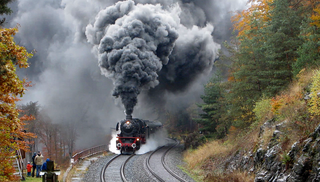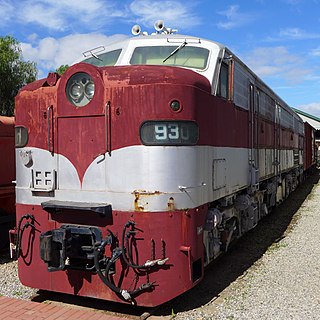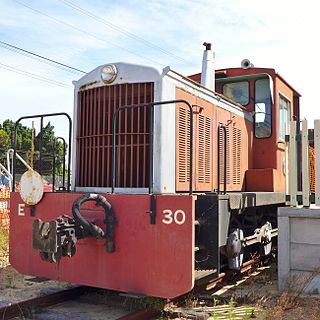Related Research Articles

A locomotive or engine is a rail transport vehicle that provides the motive power for a train. If a locomotive is capable of carrying a payload, it is usually rather referred to as a multiple unit, motor coach, railcar or power car; the use of these self-propelled vehicles is increasingly common for passenger trains, but rare for freight.

A steam locomotive is a type of railway locomotive that produces its pulling power through a steam engine. These locomotives are fueled by burning combustible material – usually coal, wood, or oil – to produce steam in a boiler. The steam moves reciprocating pistons which are mechanically connected to the locomotive's main wheels (drivers). Both fuel and water supplies are carried with the locomotive, either on the locomotive itself or in wagons (tenders) pulled behind.

A switcher or shunter is a small railroad locomotive intended not for moving trains over long distances but rather for assembling trains ready for a road locomotive to take over, disassembling a train that has been brought in, and generally moving railroad cars around – a process usually known as switching (USA) or shunting (UK). They do this in classification yards. Switchers may also make short transfer runs and even be the only motive power on branch lines and switching and terminal railroads. The term can also be used to describe the workers operating these engines or engaged in directing shunting operations.

A diesel locomotive is a type of railway locomotive in which the prime mover is a diesel engine. Several types of diesel locomotive have been developed, differing mainly in the means by which mechanical power is conveyed to the driving wheels.

The Baldwin Locomotive Works (BLW) was an American manufacturer of railroad locomotives from 1825 to 1956. Originally located in Philadelphia, it moved to nearby Eddystone, Pennsylvania, in the early 20th century. The company was for decades the world's largest producer of steam locomotives, but struggled to compete as demand switched to diesel locomotives. Baldwin produced the last of its 70,000-plus locomotives in 1956 and went out of business in 1972.

The Hunslet Engine Company was founded in 1864 in Hunslet, Leeds, England. The company manufactured steam-powered shunting locomotives for over 100 years, and currently manufactures diesel-engined shunting locomotives.
Vossloh AG is a rail technology company based in Werdohl in the state of North Rhine-Westphalia, Germany. The SDAX-listed group has achieved sales of around €930 million in 2016 with more than 4,000 employees.

Dieselisation or dieselization is the conversion to diesel fuel in vehicles, as opposed to gasoline or steam engines, particularly in reference to the replacement of steam locomotives by diesel locomotives from the 1930s to the 1960s.
Kitson and Company was a locomotive manufacturer based in Hunslet, Leeds, West Yorkshire, England.

3801 is a 4-6-2 steam locomotive operated by the New South Wales Government Railways between 1943 and 1974. It is arguably Australia's most famous steam locomotive, being the only one to have visited all mainland states and territories.

The Victorian Railways H class was an express passenger steam locomotive operated by the Victorian Railways from 1941 to 1958. Intended to eliminate the use of double heading A2 class locomotives on The Overland services on the steeply graded Western line to Adelaide, wartime restrictions led to only one locomotive being built. Nicknamed Heavy Harry, H220 was the largest locomotive ever built in Australia and the largest non-articulated steam locomotive to run on Australian railways.

The New South Wales 42 class was a class of diesel locomotives built by Clyde Engineering, Granville for the New South Wales Government Railways in 1955/56.

The Gulflander is an passenger train operated by Queensland Rail on the isolated Normanton to Croydon line in the Gulf Country of northern Queensland, Australia.
The South Australian Railways 400 class was a class of 4-8-2+2-8-4 articulated steam locomotives built in France in 1952 and 1953 under licence to Beyer, Peacock & Co. Ltd, Manchester, UK. The locomotives mainly hauled ore on the 3 ft 6 in narrow gauge line from the SA/NSW border to smelters at Port Pirie until 1963, when they were replaced by diesel locomotives. They also operated on the lines to Terowie and Quorn. Some locomotives were returned to service in 1969 while narrow gauge diesel locomotives were converted to 4 ft 8 1⁄2 instandard gauge. Subsequently some were stored at Peterborough before being scrapped.

The SAR 930 class was a class of diesel-electric locomotives built by AE Goodwin, Auburn for the South Australian Railways between 1955 and 1967.

The 900 class were a class of diesel locomotives built by Islington Railway Workshops for the South Australian Railways between 1951 and 1953.

The MRWA E class was a single member class of diesel-hydraulic shunting (switching) locomotive built by Commonwealth Engineering, Bassendean, Western Australia, for the Midland Railway of Western Australia (MRWA) in 1957. The locomotive was later owned and operated by the MRWA's successor, the Western Australian Government Railways (WAGR).

The WAGR Q class was a two-member class of 4-6-0 steam locomotives operated by the Public Works Department (PWD) and later Western Australian Government Railways (WAGR) between 1928 and 1953.

The South Australian Railways 700 class was a class of 2-8-2 steam locomotives operated by the South Australian Railways.

Electric Loco Shed, Arakkonam is a motive power depot performing locomotive maintenance and repair facility for electric locomotives of the Indian Railways,located at Arrakkonam on the Guntakal-Chennai Egmore section of the Southern Railway zone in Tamil Nadu, India. It is one of the three electric locomotive sheds of the Southern Railway, the others being at Erode (ED) and Royapuram (RPM) and is the oldest in south India. As of 1 May 2020 there are 177 locomotives in the shed.
References
- ↑ Title page Locomotion Issue 2
| This Australian rail-related article is a stub. You can help Wikipedia by expanding it. |
| This transport magazine or journal-related article is a stub. You can help Wikipedia by expanding it. See tips for writing articles about magazines. Further suggestions might be found on the article's talk page. |